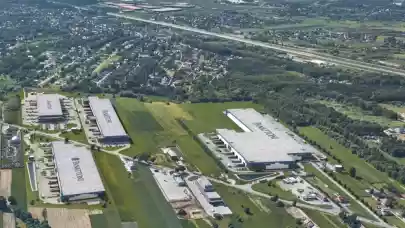
Tenants are responding to the change in customer preferences and are now increasingly likely to choose retail premises in modern residential areas. As JLL found in Miasteczko Wilanów in Warsaw, 2021 has seen the number of ground floor units grow by more than 100, an almost 25% increase on 2018. This trend is not limited to the capital city.
The boom in Poland's residential market is in full swing, with the number of apartments delivered increasing by 69% over the past decade in Poland and by 152% in Warsaw alone (according to the Central Statistical Office, 2020 vs. 2011). The growth of this sector, combined with the 15-minute city concept as well as the shift in customer preferences towards locality means that alternative retail locations – including retail units on the ground floors of residential buildings – are now an important component on the retail map.
”The pandemic has undoubtedly reinforced the trend towards diversification and locality. However, increasing shopping activity in close proximity to where one lives, especially in newly developed residential areas, has already been observed for several years. This is confirmed by JLL data, which shows that the share of residential investments with retail units on the ground floor increased from 25% between 2001 and 2010 to 36% in the last decade” says Anna Wdowiak, Director, Retail Agency, JLL.
The city within a city and the retail offer
Across the world, the concept of 15-minute cities is gaining in importance, with a move away from mono-functional neighbourhoods towards mixed-use developments. In fact, this means that most daily needs such as work, education, shopping and entertainment can be met within the neighbourhood or district. A health clinic, park, school, office or shop can be reached within a 15-minute walk or bike ride by residents. In addition, short distances save time on journeys and reduce traffic, which translates into increased comfort for residents and more sustainable use of resources. The 15-minute city concept also contributes to the growing importance of a local, neighbourhood-based retail, service and F&B offer.
“A properly planned retail and services offer in residential buildings can be an important city-forming factor in the development of a city, increasing the attractiveness of the project itself, the immediate neighbourhood as well as attracting local residents. Thinking about the role of these spaces should therefore extend beyond the scope of the project, and beyond the boundaries of the plot on which a project would be built. The competitive retail and service offer, however, requires appropriate preparation and consideration of various functions at the investment planning stage”, comments Jan Jakub Zombirt, Director, Strategic Consulting, JLL.
”It is also essential that these plans are reviewed and adjusted to the current needs of the residents during the operational phase of the complex as well. This, combined with the greater receptiveness of tenants to locations in residential neighbourhoods and an increased offer of units tailored to their needs, opens up new opportunities for retailers to reach potential customers”, adds Anna Wdowiak.
Modern residential schemes follow the trend
The challenge for the retail industry now is to mitigate the impact of the COVID-19. Expansion of shopping activity into residential areas is one way to diversify distribution channels and mitigate potential risks associated with the pandemic. According to a survey carried out by JLL in 2021, the most important elements analyzed by retail chains when considering new locations in residential complexes include the scale of the estate (market potential) and the competition.
”As residential areas and buyers' preferences change, so too does the retail and service offer, which especially in newer residential districts, is characterised by a larger number health & beauty centres, aesthetic medicine clinics, health food stores, language schools, as well as a wide range of cafes and restaurants. At the same time, residents' expectations of the quality of retail and service facilities in the vicinity of their homes are also growing”, explains Joanna Tomczyk, Senior Research Analyst, JLL.
Miasteczko Wilanów on solid "ground floors"
Confirmation of these trends may be the example of one of the newer districts of Warsaw – Wilanów, and more specifically one of its residential areas, i.e. Miasteczko Wilanów.
“JLL data shows that on the back of a wave of residential market growth, the number of retail units on the ground floors of residential buildings in Miasteczko Wilanów has increased by more than 100 since 2018, while vacancy levels have fallen”, comments Joanna Tomczyk.
According to an analysis by JLL, the ground floors of residential buildings in Miasteczko Wilanów currently provide 564 commercial units with a total area of approx. 45,000 sqm. The largest number of retail units, 31%, is occupied by a wide range of services, including beauty salons, hairdressers, language schools, travel agencies, florists, launderettes and currency exchange offices. Cafes and restaurants are next with14% of all premises, followed by groceries with just over 13%. As much as 87% of the retail space in Miasteczko Wilanów is leased.
A comparison of the 2018 and 2021 surveys shows that over the past three years, the number of new retail units in Miasteczko Wilanów has grown from 459 to 564, an increase of 23%.
”The structure of premises in residential estates has changed slightly from our first survey conducted in 2018. The three-year period saw a 2 p.p. increase in grocery shops. To a slightly lesser extent, the importance of the health & beauty, and food and services categories increased. However, the share of banks and financial institutions, as well as fashion stores, have declined”, explains Joanna Tomczyk.
The example of Miasteczko Wilanów clearly indicates that premises on the ground floors of residential buildings can easily adapt to the current market realities. The potential of millions of sqm in the shape of residential areas across Poland for the retail sector is clearly evident. And this could provide a timely boost for the ‘brick and mortar’ retail sector.
”In such a difficult year for the retail market, the share of vacant premises in Miasteczko Wilanów dropped from 15% to 13%. This is an exceptional and distinctive phenomenon compared to those observed in shopping centres and on high streets”, explains Joanna Tomczyk.



